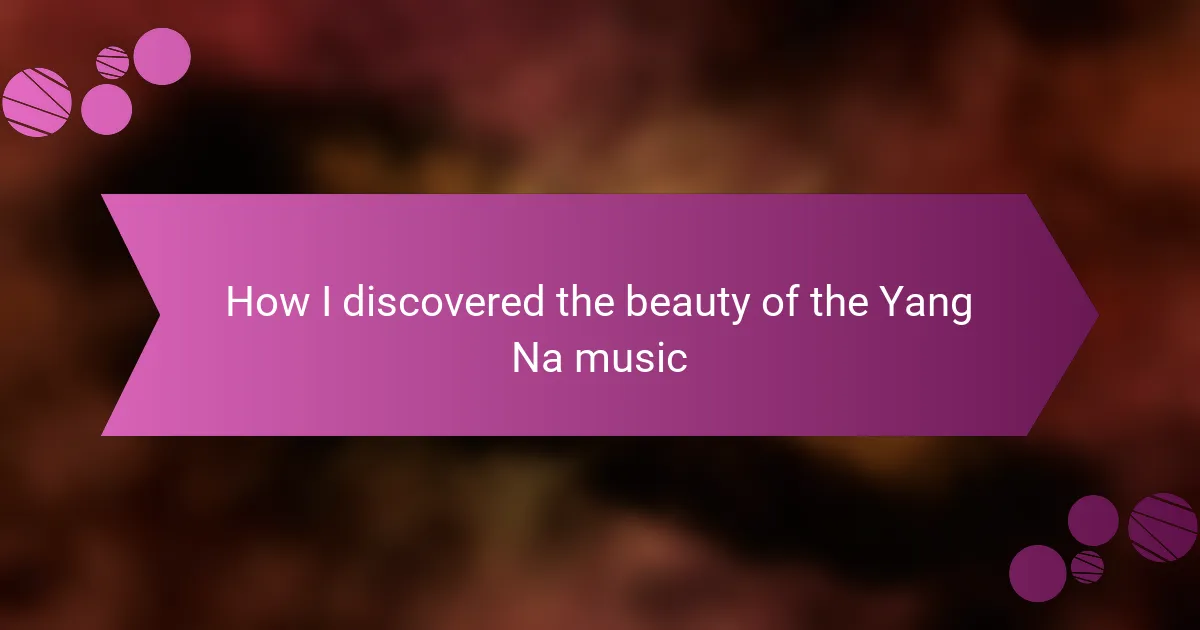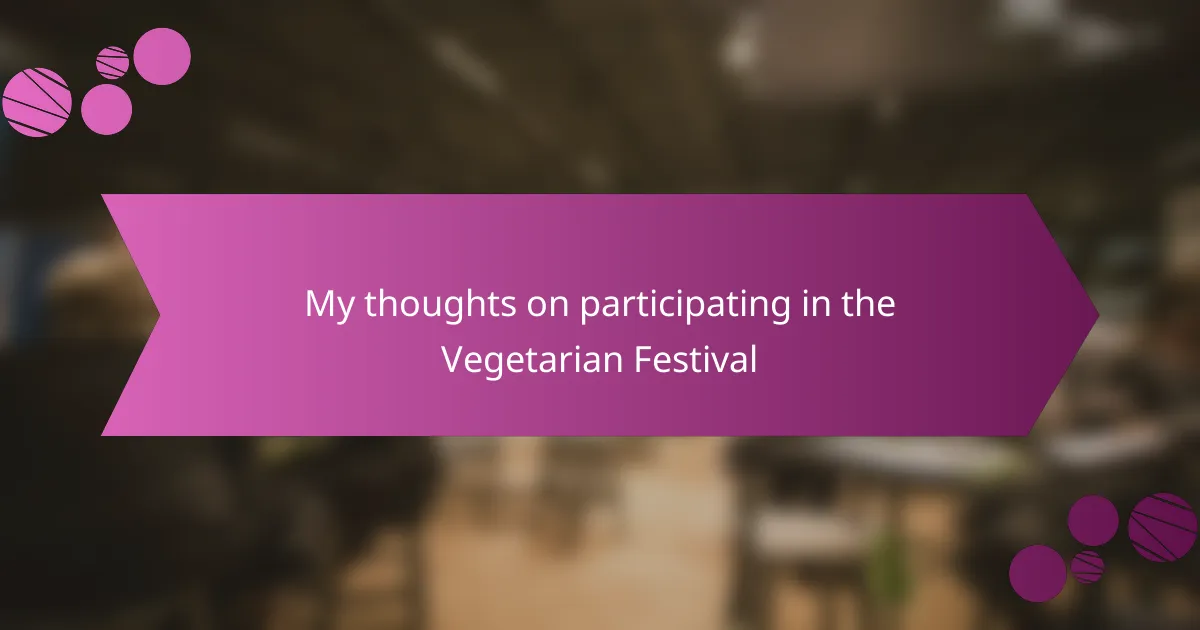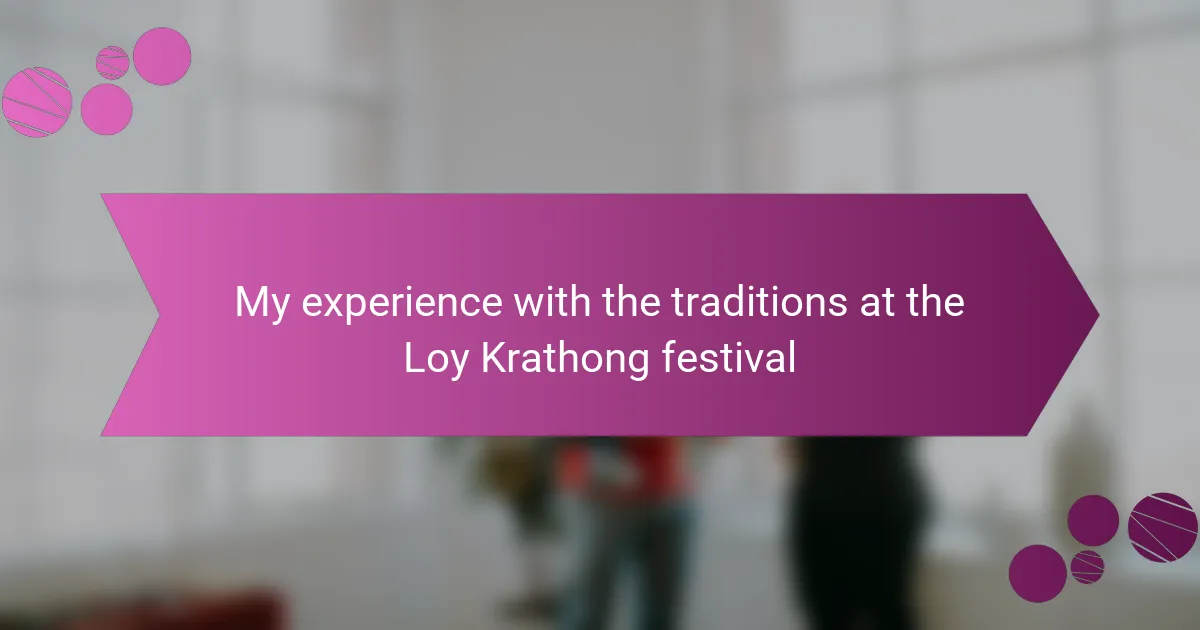Key takeaways
- Thai music festivals, such as the Chiang Mai Flower Festival and Songkran Festival, celebrate the fusion of traditional and contemporary music, fostering community connections.
- Yang Na music serves as a bridge between tradition and modernity, using traditional instruments to evoke emotions and encourage community participation during celebrations.
- Experiences at Thai music festivals highlight the vibrant atmosphere and the power of music to connect individuals, transcending cultural boundaries and creating lasting memories.
- The emotional impact of Yang Na music leads to a deeper appreciation of Thai culture, fostering a sense of belonging and unity among attendees.
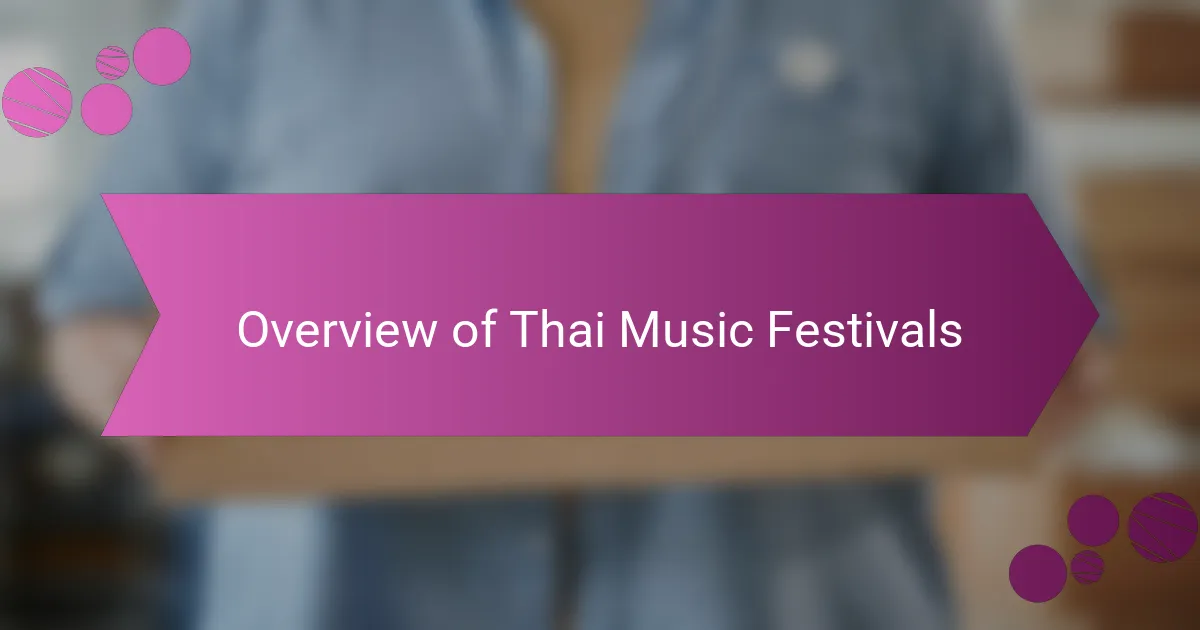
Overview of Thai music festivals
Thai music festivals are vibrant celebrations that showcase the rich tapestry of Thailand’s cultural heritage through its music, dance, and art. I remember my first experience at the Chiang Mai Flower Festival, where the street filled with the sounds of traditional instruments and contemporary rhythms. It was a feast for the senses, illustrating how Thai festivals seamlessly blend the old with the new, creating an inviting atmosphere for everyone.
Another remarkable festival is the Songkran Festival, which is celebrated with joyous water fights and lively music, capturing the spirit of renewal and joy. Each event not only highlights the talent of local musicians but also fosters a sense of community and connection among attendees. As someone who cherishes these experiences, I’ve found that the music brings people together in ways that words often cannot.
Here’s a quick comparison of some notable Thai music festivals:
| Festival | Features |
|---|---|
| Chiang Mai Flower Festival | Traditional music, vibrant parades, floral displays |
| Songkran Festival | Water fights, lively street performances, cultural rituals |
| Bangkok International Festival | Global music acts, fusion genres, cultural showcases |
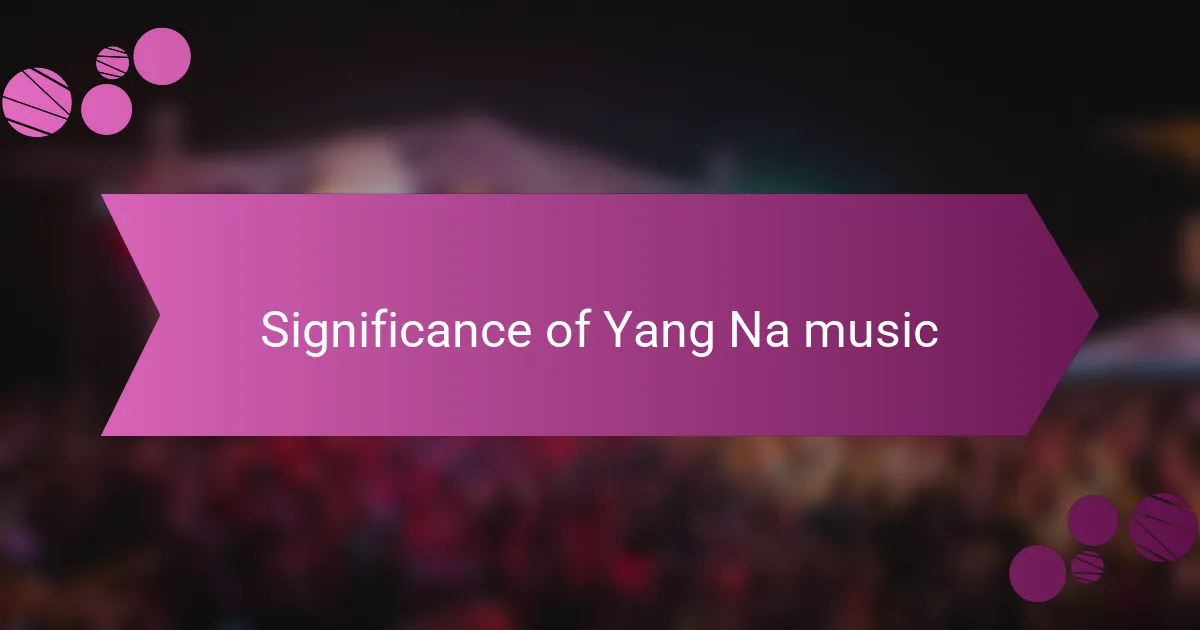
Significance of Yang Na music
Yang Na music holds a significant place in Thai culture, serving as a bridge between tradition and modernity. When I first encountered it during a local festival, I felt an immediate connection to the rhythms and melodies that resonated deeply within me. The music’s ability to tell stories and convey emotions reminded me of the rich cultural heritage that Thailand is renowned for.
What truly strikes me about Yang Na music is its unique ability to evoke a range of feelings in its listeners. The blend of traditional instruments with contemporary styles creates an atmosphere that feels both familiar and refreshing. Reflecting on my experiences, I appreciate how it encourages community bonding and fosters a sense of belonging during celebrations.
- Incorporates traditional Thai instruments, like the ranat (xylophone) and khim (hammered dulcimer).
- Blends old melodies with contemporary influences, making it appealing to younger audiences.
- Evokes a strong emotional response, often connecting people to their cultural roots.
- Features in various traditional ceremonies, enhancing their spiritual significance.
- Encourages community participation, fostering a sense of unity among listeners.
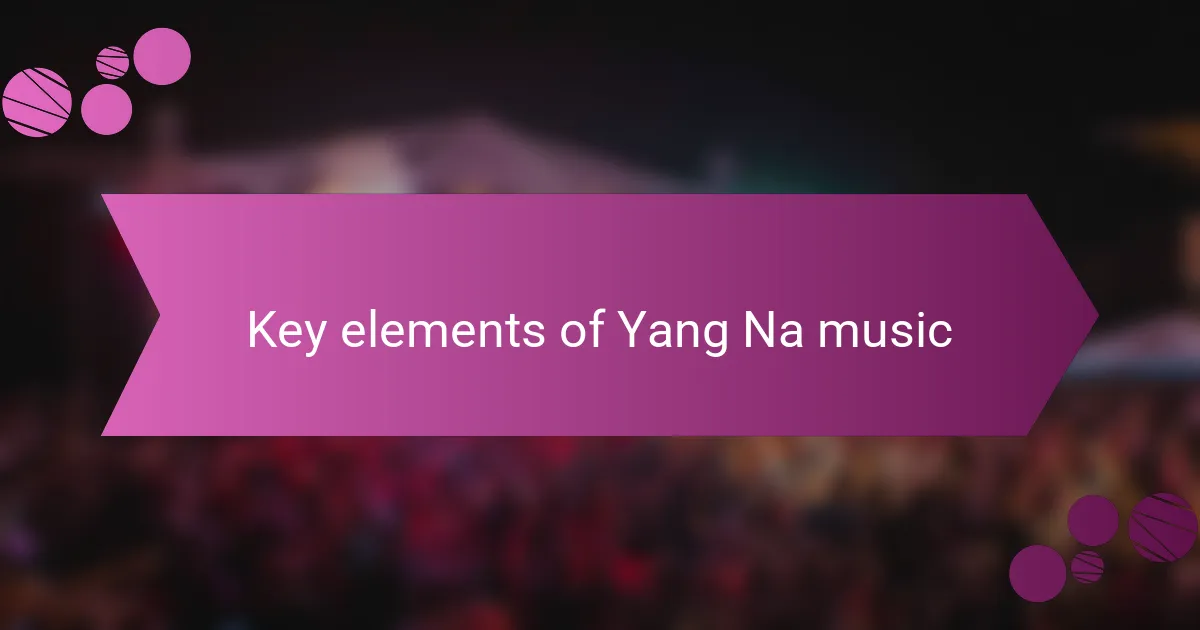
Key elements of Yang Na music
When I first immersed myself in Yang Na music, I quickly realized how its key elements create a rich tapestry of sound that resonates deeply with its audience. The intricate rhythms, often driven by traditional instruments like the phin and khaen, evoke a sense of nostalgia. The combination of these instruments with melodic vocals creates a unique experience that I can only describe as exhilarating.
One memorable encounter was at a local festival, where the pulsating beats drew everyone in. It felt as if the entire crowd was connected, swaying in rhythm together—a beautiful reminder of how music transcends boundaries.
Here’s a comparison table that highlights some key elements of Yang Na music:
| Element | Description |
|---|---|
| Instrumentation | Primarily uses traditional instruments such as the phin, khaen, and drums to create layered sounds. |
| Vocals | Features expressive singing that conveys deep emotions, often telling stories of love and life. |
| Rhythm | Complex, syncopated rhythms that encourage movement and connection among listeners. |

Personal journey discovering Yang Na
As I dove into the world of Thai music, I stumbled upon Yang Na music quite by accident at a local festival. The warm melodies and intricate rhythms captivated me immediately. I still remember the moment I first heard the sound of the khaen, a traditional mouth organ that added a rich texture to the music, filling the air with an enchanting atmosphere.
The experience was transformative, sparking a deep appreciation for the art form. It reminded me of my childhood, where music often told stories, evoking emotions that I hadn’t fully understood until then. Each note felt like a connection to the history and culture of Thailand, and I found myself wanting to explore more.
Embracing Yang Na was like discovering an unseen layer of beauty in a culture that I had only begun to understand. The sounds resonated with my heart, and I found joy in the communal spirit of the performances, where everyone was invited to celebrate and connect through music.
| Aspect | Yang Na Music |
|---|---|
| Instruments | Khaen, drums, and flutes |
| Emotion | Deep connection to Thai culture |
| Experience | Vibrant and communal |
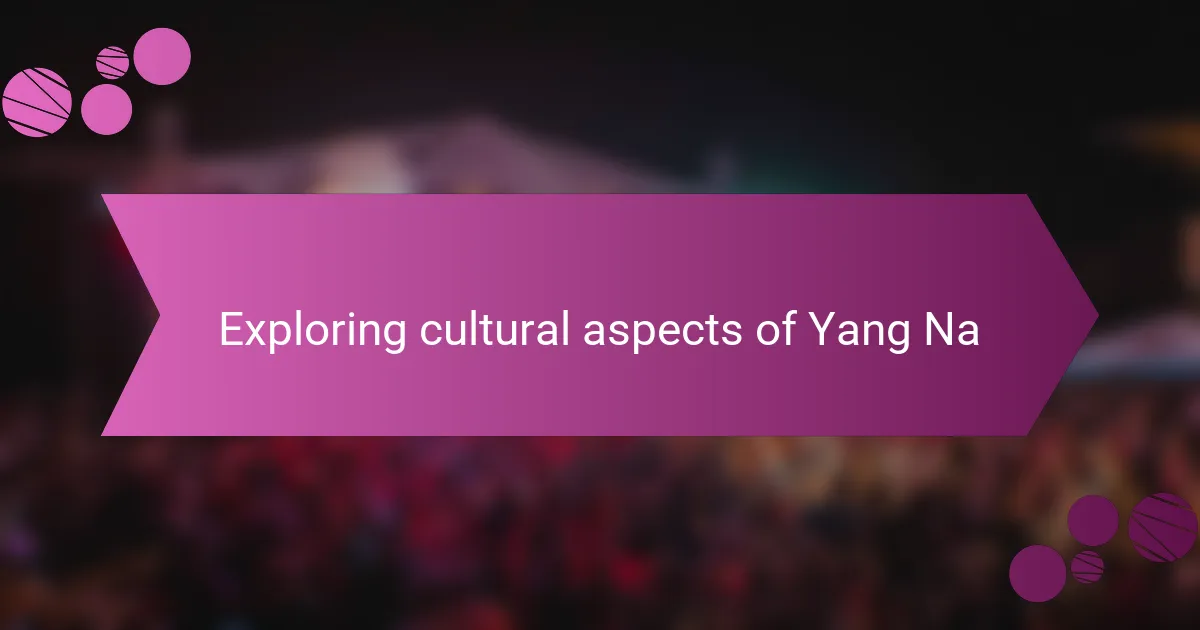
Exploring cultural aspects of Yang Na
When I first dove into the world of Yang Na music, I was struck by how profoundly it embodies Thai culture. Each note seemed to weave together stories of tradition, joy, and even the struggles of everyday life in Thailand. It’s not just music; it’s a reflection of the community and their experiences, resonating deeply with anyone willing to listen.
As I explored more, I discovered that Yang Na often accompanies social gatherings, marking celebrations and rites of passage. The rhythms often remind me of my own experiences at festivals, where strangers become friends over the shared love for the music.
- Yang Na music plays a crucial role in Thai festivals, creating a festive atmosphere.
- The instruments used, like the khene and the ranat, reflect local craftsmanship and heritage.
- Many songs celebrate nature, community, and historical tales, giving listeners a sense of belonging.
- The style is improvisational, allowing musicians to express their creativity and connect on a personal level with the audience.
- Listening to Yang Na feels like engaging in a conversation with the past while celebrating the present.

Experiences at Thai music festivals
Attending Thai music festivals has been nothing short of transformative for me. The first time I experienced the lively atmosphere, I was overwhelmed by the vibrant energy in the air. Artists performing traditional Thai music, wrapped in colorful attire, effortlessly blended contemporary rhythms with classical melodies, captivating my attention.
Each festival offers a unique opportunity to dive into the rich tapestry of Thai culture. I remember standing in the crowd, surrounded by families and friends, all joined together by the healing power of music. It was in these moments that I truly understood how Yang Na music, with its enchanting melodies, fosters a connection among diverse audiences.
- Traditional instruments like the khim and ranat create an otherworldly sound.
- Festivals often include dance performances, enhancing the overall experience.
- The communal spirit allows for a safe space to express joy and gratitude.
- I discovered friendships formed over shared love for Thai music, leading to lasting bonds.
- The delicious local food stalls make the experience unforgettable, tempting your taste buds while you immerse yourself in sound.
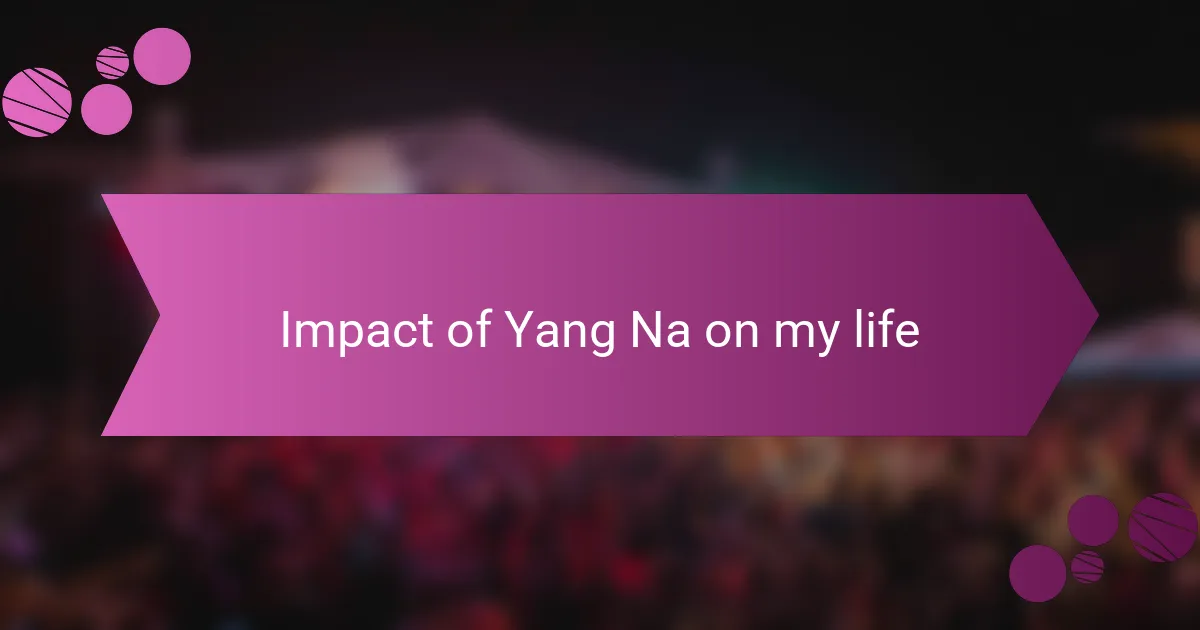
Impact of Yang Na on my life
The impact of Yang Na music on my life has been profound, and I didn’t fully realize it until I found myself among an enthralled crowd, each person swaying to the rhythm. I recall a night at a local festival when the haunting notes of the khaen wrapped around me, and I felt an undeniable pull to the music’s essence. Did you ever feel such a connection that it seemed to vibrate through your very bones? That’s what I experienced, a reminder that music has the power to transcend mere sound and touch the soul.
Yang Na has not only enhanced my appreciation for Thai culture but has also woven itself into my emotional landscape. I think back to a specific moment when a live performance brought tears to my eyes, tapping into emotions I didn’t know I had—joy, nostalgia, and a deep sense of belonging. This music carries stories that resonate with my own experiences, almost as if it’s speaking directly to me about love, struggle, and celebration.
Moreover, the communal spirit fostered by Yang Na has enriched my life in unexpected ways. I remember one festival, where I found myself sharing laughter and moments with strangers over the shared enjoyment of the live tunes. It felt like we were all part of something bigger—an orchestra of shared humanity, bound together by the universal language of music. Who knew that a simple moment of listening could open doors to new friendships and deepen my understanding of community?
